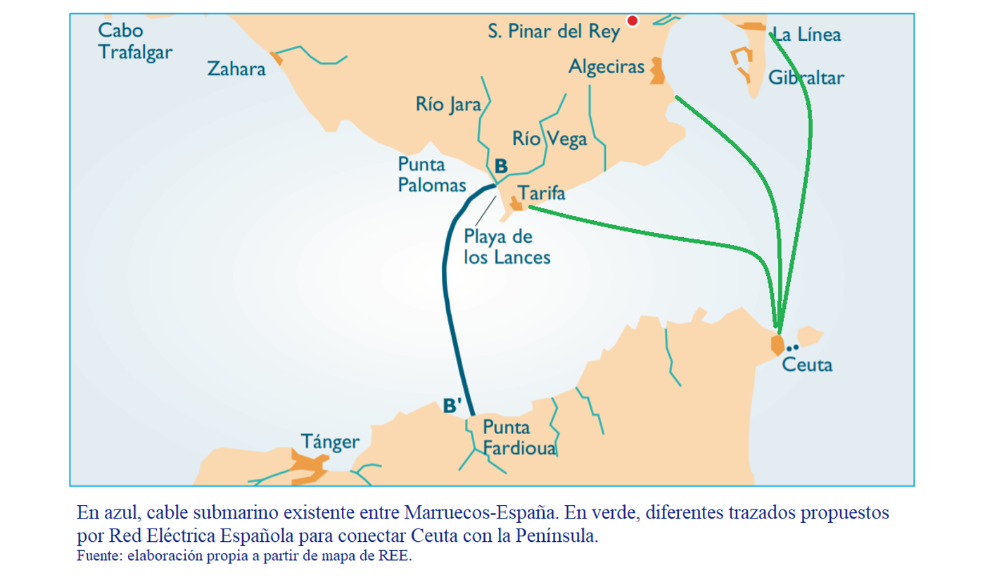The electricity interconnection project between Ceuta and the Peninsula, of the Spanish Electricity network , is already five years behind schedule. Its execution must be a priority in order to integrate the autonomous city in the future routes of the Europe-Africa connection.
article / Ignacio Urbasos Arbeloa
19.05.2021. In 1997 the submarine electrical interconnection between Tarifa and Punta Fardioua in Morocco was completed. This new connection joined the gas pipeline inaugurated in 1996 that crossed Morocco from Algeria to Spain and Portugal, forging a Spanish-Moroccan energy alliance that would allow economic development and security of energy supply for both partners. This infrastructure, with a capacity of 700 MW, was capable of supplying Morocco with nearly 50% of its annual electricity needs. This was a strategic link for the Maghreb country, which experienced a 5.8% annual growth in electricity demand during the 1990s. In 2006, this interconnection doubled its capacity to 1.4 GW, the first international interconnection between two continents in the world to reach this size. Despite recent frictions between Spain and Morocco over illegal immigration, fishing agreements and above all the Perejil incident, the recently arrived Socialist government led by José Luis Rodríguez Zapatero was committed to strengthening ties between the two sides of the Strait of Gibraltar, continuing with the energy interconnection. Although at the beginning the submarine cable was mainly used for the export of electricity from Spain, in recent years bilateral exchanges have been balancing out, as a result of Morocco's strategy of energy autonomy.
From Ceuta, the route of the submarine cable has always been considered a lost historical opportunity. The autonomous city produces electricity from old diesel generators, which apart from being inefficient and expensive, have high levels of particulate emissions in the air and greenhouse gases. The city of Ceuta is the only region in Spain that does not produce renewable electricity, a status with little room for improvement considering the scarcity of space for its development. From network Eléctrica Española there is already a plan to develop a submarine cable between La Línea (Cádiz) and Ceuta, which has encountered civil service examination from environmental groups in Cádiz and the mayor of the area, which has forced to delay its installation from 2016 to the present. The CNMC granted in February 2021 at the request of network Eléctrica Española the character of singular project to this interconnection, which should facilitate the beginning of the installation that already raises alternative routes to reach the necessary social consensus. The submarine cable will have a rapid amortization, as it will eliminate the costs associated with the isolated electricity system in Ceuta, and will allow reducing the carbon emissions of this City, in line with the Spanish Climate Strategy, which aims to achieve zero net greenhouse gas emissions by 2050. The cable will join other similar interconnection infrastructures in Spain, such as those existing between the Balearic electricity system and the Peninsula or the submarine cable linking the Bay of Biscay with the French region of Aquitaine.

The cable will also diversify future interconnections between Spain and Morocco, which should grow as Morocco increases the amount of renewable energies in its electricity mix. Morocco, which has an ambitious decarbonization strategy, is committed to the development of renewable energies as a driver of future national economic growth and as a lever to ensure its regional leadership. Morocco already has interconnections with Algeria of 1.2 GW, and is planning a connection line with Portugal and Mauritania.
In any case, it is clear that Spain is a necessarily vital partner for Morocco's green project , which aims to export both electricity and renewable hydrogen to the European Union in the future. Spain 's position as a necessary energy bridge should serve as a strong argument in bilateral negotiations. In this sense, Ceuta should become a strategic point for future extensions in the electrical interconnection on both sides of the strait. The Moroccan strategy of implicit pressure on Ceuta and Melilla by closing cross-border trade or allowing the crossing of illegal immigrants is a move that clearly meets the definition of a gray zone offensive. The Alaouite dynasty has been making public and palpable for decades, specifically since its independence in 1956, its traditional longing and strategic interest in the only two non-insular territories that Spain has in North Africa. Connecting the peninsular electricity system with Ceuta should be considered as a strategic project for the benefit of national energy security, the reduction of greenhouse gases and the improvement of air quality. In addition, raising Ceuta as a necessary crossing point in the future electricity interconnections between Africa and Europe would offer Spain deterrence and negotiation capacity against a Morocco that does not hesitate to use direct pressure on the cities of Ceuta and Melilla to achieve its objectives in the bilateral relations Spain-Morocco.